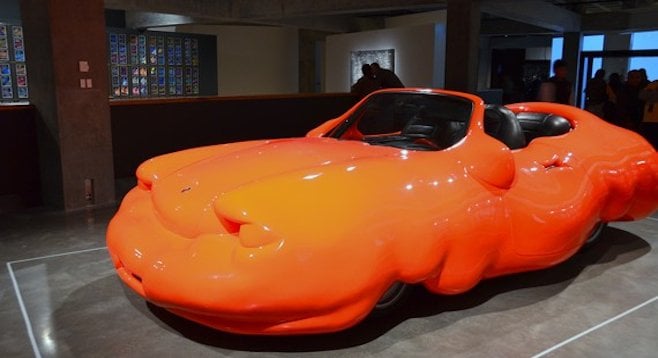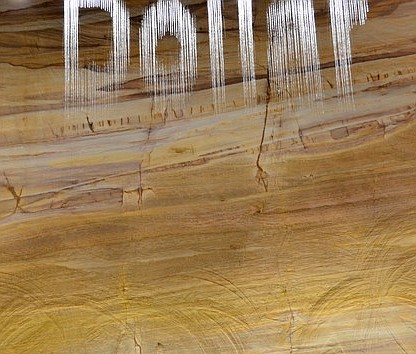 Facebook
Facebook
 X
X
 Instagram
Instagram
 TikTok
TikTok
 Youtube
Youtube

It just opened on January 21, 2011, and already it's the most talked-about museum in the world.
And who could have guessed? David Walsh, the eccentric pro gambler and millionaire founder of MONA, or the Museum of Old and New Art (Australia’s largest private museum), has broken just about every rule in the museum rulebook.
If such a rulebook existed, these might be some of its mandates:
1) Don’t build a museum in a remote place where people have to get off the beaten track. Numbers count.
MONA is located in Tasmania, Australia – just about as far south in the Southern Hemisphere as one can travel without ending up on some iceberg in the Antarctic. What was David Walsh thinking?
2) Construct a museum around mainstream (or at least socially acceptable) ideas and themes.
MONA focuses on topics like sexual obsession and death by anesthesia – hardly topics that most families would want to take their kids to see. Yet despite warnings at MONA about content being somewhat provocative for the under-18 set, families as well as couples and singles flock to the museum in droves.
Attendees may not love what they see; in fact, there's an option to vote whether it is “love” or “hate” regarding an installation, but the outcome is that people talk about their experience. This is good.
3) While museum installations can be interactive, they shouldn't smell or offend people.
Once again, David Walsh refuses to listen to well-meaning advisors by exploring the topics of euthanasia and feces.
Cloaca Professional is a machine with five large glass bottles connected by tubes into which food from the gallery’s food establishments is fed daily for an outcome of feces onto a plate. Not only is this yuck, but it smells to high heavens!
And as if this abject art's not enough, Walsh explores the topic of euthanasia through an interactive work by Greg Taylor and Dr. Philip Nitschke that includes a euthanasia machine alongside a table and leather armchair.
The intensity of termination is documented by computer descriptions of bodily functions that cease to function at certain countdowns. It is both provocative and disgusting.
4) Charge everyone for admission; the museum has acquisition, operating and maintenance costs to pay. (We won’t even discuss insurance or liability aspects.)
The entry fee to MONA is only $20 AD, and is free for Tasmanians and those under 18. Go figure how they turn a profit.
5) Maintain certain standards of decency by avoiding the vulgar and obscene.
To this David Walsh says, “…The most important forces behind me and this museum stem from my dark side. That being said, here are the lies you have to be told...”
6) Keep cutting-edge technology at an affordable minimum, as it can detract from profit margins.
Not only has David Walsh ignored this mantra, but he's managed to be at the leading edge to the point where the U.S.'s Smithsonian has sent down teams to explore the smart technology MONA uses when they issue GPS-enabled devices that allow museum-goers to vote on their opinions and register what they've seen. They can also drill down to see more information on any particular exhibit.

Forget the fact that Walsh has broken all the rules (no matter how contrived they may be by yours truly). What seems most important is that it's art exhibited not for the sake of art alone, but for the sake of promoting dialogue.
Often provocative and controversial, the art exhibited in MONA is for the sake of conversation. Here the museum wildly succeeds; there's scantly an individual who leaves without opining some strong feelings or views.
See for yourself what the controversy is all about, and decide whether it merits discussion on a global scale or should be banished to the realms of the obscene, trivial and mundane.


It just opened on January 21, 2011, and already it's the most talked-about museum in the world.
And who could have guessed? David Walsh, the eccentric pro gambler and millionaire founder of MONA, or the Museum of Old and New Art (Australia’s largest private museum), has broken just about every rule in the museum rulebook.
If such a rulebook existed, these might be some of its mandates:
1) Don’t build a museum in a remote place where people have to get off the beaten track. Numbers count.
MONA is located in Tasmania, Australia – just about as far south in the Southern Hemisphere as one can travel without ending up on some iceberg in the Antarctic. What was David Walsh thinking?
2) Construct a museum around mainstream (or at least socially acceptable) ideas and themes.
MONA focuses on topics like sexual obsession and death by anesthesia – hardly topics that most families would want to take their kids to see. Yet despite warnings at MONA about content being somewhat provocative for the under-18 set, families as well as couples and singles flock to the museum in droves.
Attendees may not love what they see; in fact, there's an option to vote whether it is “love” or “hate” regarding an installation, but the outcome is that people talk about their experience. This is good.
3) While museum installations can be interactive, they shouldn't smell or offend people.
Once again, David Walsh refuses to listen to well-meaning advisors by exploring the topics of euthanasia and feces.
Cloaca Professional is a machine with five large glass bottles connected by tubes into which food from the gallery’s food establishments is fed daily for an outcome of feces onto a plate. Not only is this yuck, but it smells to high heavens!
And as if this abject art's not enough, Walsh explores the topic of euthanasia through an interactive work by Greg Taylor and Dr. Philip Nitschke that includes a euthanasia machine alongside a table and leather armchair.
The intensity of termination is documented by computer descriptions of bodily functions that cease to function at certain countdowns. It is both provocative and disgusting.
4) Charge everyone for admission; the museum has acquisition, operating and maintenance costs to pay. (We won’t even discuss insurance or liability aspects.)
The entry fee to MONA is only $20 AD, and is free for Tasmanians and those under 18. Go figure how they turn a profit.
5) Maintain certain standards of decency by avoiding the vulgar and obscene.
To this David Walsh says, “…The most important forces behind me and this museum stem from my dark side. That being said, here are the lies you have to be told...”
6) Keep cutting-edge technology at an affordable minimum, as it can detract from profit margins.
Not only has David Walsh ignored this mantra, but he's managed to be at the leading edge to the point where the U.S.'s Smithsonian has sent down teams to explore the smart technology MONA uses when they issue GPS-enabled devices that allow museum-goers to vote on their opinions and register what they've seen. They can also drill down to see more information on any particular exhibit.

Forget the fact that Walsh has broken all the rules (no matter how contrived they may be by yours truly). What seems most important is that it's art exhibited not for the sake of art alone, but for the sake of promoting dialogue.
Often provocative and controversial, the art exhibited in MONA is for the sake of conversation. Here the museum wildly succeeds; there's scantly an individual who leaves without opining some strong feelings or views.
See for yourself what the controversy is all about, and decide whether it merits discussion on a global scale or should be banished to the realms of the obscene, trivial and mundane.
Comments